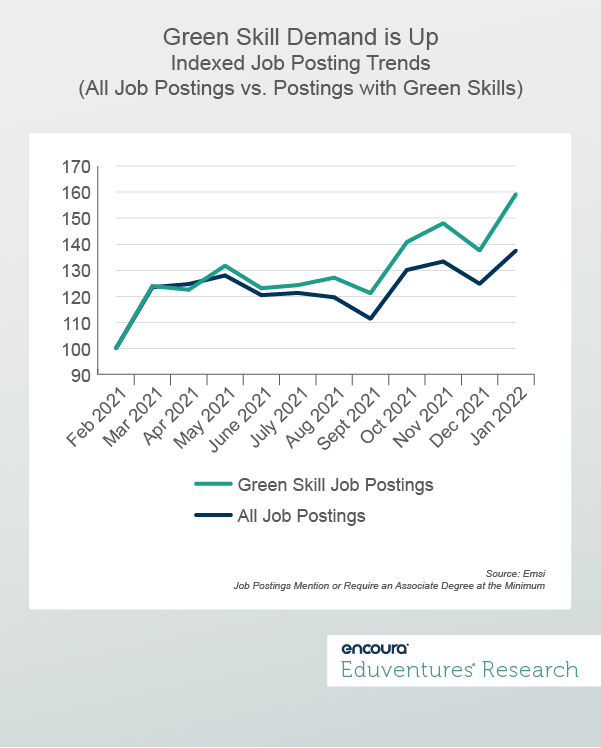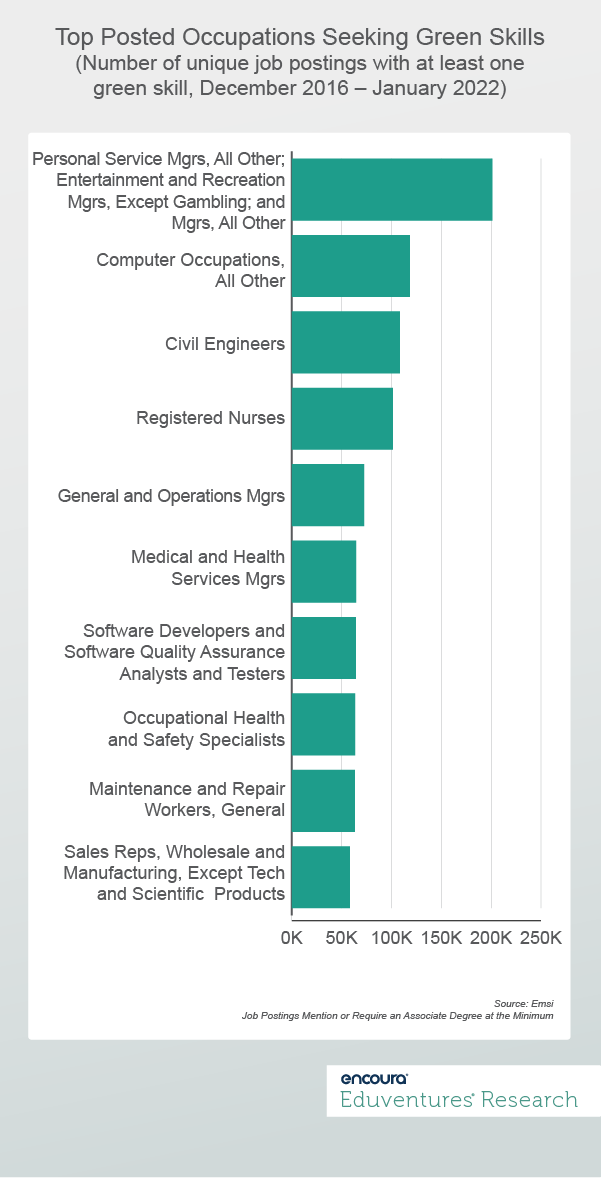Recently, Eduventures has seen an increase in inquiries around green jobs. These questions, coincidentally or not, bubbled up around the same time that the United Nations’ Intergovernmental Panel on Climate Change released its most recent report with the latest global consensus on climate science. Its findings? Climate change is impacting the world faster than expected and the window for countries to act is closing. A sobering assessment to say the least.
With these questions top of mind and this report shining renewed light on the stakes, what better time to understand the green job landscape?
Student Demand
Before actually diving into the green job labor market, it is critical to point out student interest and demand for these developments. Consider the following trends:
- 86% of U.S. college freshmen agreed that addressing global climate change should be a federal priority, according to UCLA’s 2020 American Freshman Survey.
- 32% of Gen Z and 28% of Millennials report having taken personal action to help address climate change compared to 23% of Gen Xers and 21% of Baby Boomers, according to PEW Research.
- , such as: natural resources and conservation (5% growth, combined bachelor’s and master’s), environmental science (57%), environmental studies (40%), environmental engineering (48%), and natural resources management and policy (21%).
- Perhaps most tellingly is the growth in sustainability studies, a program that focuses on the concept of sustainability from an interdisciplinary perspective. Interest has skyrocketed (385%) between 2012-2020. Though starting from a very small base, the idea of blending sustainability concepts with business, urban planning, and other distinct fields of study shows promise.
All this data points to real momentum among students in finding academic programming that follows their passions. The question is, how does this student momentum translate into green jobs?
Mapping the Green Job Market
Through the Bureau of Labor Statistics (BLS), the question of green job demand is unfortunately not as straightforward as it should be. In 2013, the BLS created a definition, declaring that green jobs are:
- jobs in businesses that produce goods or provide services that benefit the environment or conserve natural resources.
- jobs in which workers' duties involve making their establishment's production processes more environmentally friendly or use fewer natural resources.
While this definition provides solid grounding for understanding what green jobs are, it doesn’t translate to the BLS Standard Occupational Classification (SOC) System, where users can track projected job growth in specific occupations. This system works best when mapping occupations with clear career articulation and established professional pathways, such as accountants or chemists. But when assessing the outlook for green jobs, limitations set in.
Simply put, the BLS naturally creates a narrow scope of what green jobs are. We can identify occupations that naturally fit into the green job category, such as environmental engineers and environmental scientists and specialists, but these occupations are rather narrow in scope and don’t capture the entire green job ecosystem.
Additionally, many relevant BLS SOC codes most aligned to green jobs do not suggest explosive projected growth, which contradicts much of the commentary around these jobs over the last decade. Table 1 shows that a sample of relevant green occupations, as defined by the BLS, are projected to grow just above or below the national average over the next decade and signal relatively small occupational groups.
Green Occupational Projections through BLS
| Occupation | 2022 Jobs | 2031 Jobs | # Change | % Change |
|---|---|---|---|---|
| Environmental Engineers | 52,067 | 54,031 | 1,964 | 4% |
| Conservation Scientists | 24,625 | 25,697 | 1,072 | 4% |
| Environmental Scientists | 88,028 | 94,508 | 6,480 | 7% |
| All National Occupations | 149,987,171 | 159,722,792 | 9,735,621 | 6% |
Table 1.
Source: BLS
With that, focused skills analysis may be more illustrative than the BLS projection data when tracking green job demand in the labor market. Figure 1 tracks job posting trends, contrasting overall job postings with those postings containing at least one green skill (as defined by Emsi).Critically, the World Economic Forum has said that there is no single green industry anymore, rather, green jobs span across a range of roles and sectors. By this thinking, a software developer working for Tesla and an urban planner focused on sustainable design are considered green jobs. Taking this even further, LinkedIn views the greening economy through the shift in skills required as companies and countries alike strive to meet emissions targets and other climate-focused initiatives. These skill shifts range from investment analysts who assess climate impacts on portfolios to product designers rethinking traditional packaging design for reuse.

As Figure 1 reveals, job postings containing a green skill (ranging from sustainability to pollution prevention to green building) have outpaced overall job postings over the last year by more than 20% (59% vs. 37%). Mapping these job postings back to occupations reveals how the walls around the green industry truly have broken down.
Figure 2 shows the 10 occupations with the most unique job postings mentioning at least one green skill over the last five years.

While job posting analysis can create some skepticism given the web scraping used to capture this information, the results do show a variety of occupations ranging from civil engineers, to software developers, to medical and health services managers showing the true breadth of industry penetration that aligns with other research on this subject.
The Bottom Line
Green job trends suggest the need for programming designed to prepare professionals across industries with skills that are useful in the greening economy, and market trends suggest a student population hungry for this type of programming. With the next generation poised to care even deeper about these issues, it is hard to see this interest simply as a bubble.
For schools, this means a potential to address both labor market need and student demand. A couple of strategies could include:
- Focused Programming. Many schools have developed specific programs covering sustainability themes, like Columbia University’s Climate School (established in 2020 and connecting other university initiatives like the Earth Institute). The Climate School acts as a hub for all of Columbia’s sustainability-aligned programming like its master’s in sustainability science, a STEM-focused program for those wishing to pursue a career in the technical aspects of sustainability, and the master’s in sustainability management, a management program accounting for both the environment and the economy.
- Broader Sustainability Curriculum Efforts. Other schools have created broader curriculum initiatives encompassing sustainability themes across a range of programming. George Mason University, for example, has designated several of its courses as Green Leaf Courses that cover “the social, economic, and environmental dimensions of sustainability.” Courses range from sustainability-focused offerings like environmental economics and energy policy to sustainability-related courses like social marketing and soil science. Courses are bundled and offered as part of a suite of degree programs, from environmental science, to tourism and events management, to health, fitness, and recreation resources showing the full range of green-themed outcomes.
Either strategy can be effective based on a school’s expertise, capacity, and current offerings. In the future, a less commoditized approach, seeing green themes woven across general curriculum requirements may best match the trends we’ve seen in the labor market – where “green” walls have been knocked down.
Never Miss Your Wake-Up Call
Learn more about our team of expert research analysts here.
Eduventures Senior Analyst at Encoura
Contact
The Program Strength Assessment (PSA) is a data-driven way for higher education leaders to objectively evaluate their programs against internal and external benchmarks. By leveraging the unparalleled data sets and deep expertise of Eduventures, we’re able to objectively identify where your program strengths intersect with traditional, adult, and graduate students’ values, so you can create a productive and distinctive program portfolio.
A small, private university located in Maine, Husson University stands apart as the only New England institution focused primarily on professional careers and driven to “educate students for the jobs that do not yet exist.” With a mission to drive purpose and opportunity to its student body, Husson serves as an institution that excels in both affordability and outcomes for undergraduates and graduates.

